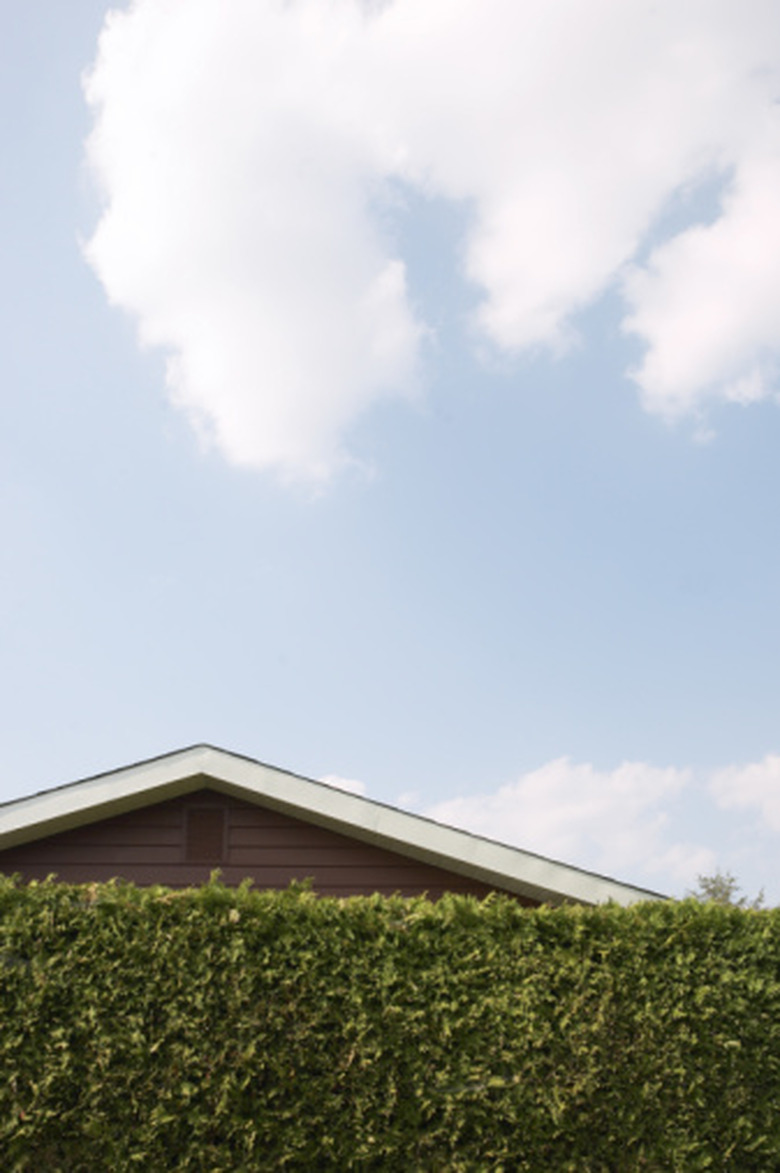My Green Hedge Is Turning Yellow
Shrubs and other bushy plants growing as hedges can come under attack from a variety of insects and diseases that turn the plants' leaves yellow. Additionally, cultural problems, meaning adverse factors in the plants' growing conditions and treatment, can cause premature yellowing of shrubs. Hedges may contain leafy plants, vines or needled evergreens, and may be flowering plants or foliage plants. Different types of hedges may be susceptible to different problems. Knowing what affects some commonly grown hedges may help you determine what is ailing your own.
Insect Pests
Aphids, mites, lace bugs, borers and leafminers attack many species of woody plants, including boxwood, privet, Indian hawthorn, holly and evergreens. These insects suck vital juices from the leaves, stems and branches, causing leaves to turn partially or completely yellow. The leaves may die or drop off the plant prematurely. Leafminers hatch inside leaves while the larvae of borers burrow beneath the bark to feed. Some insects that do little damage to the plant themselves can transmit often deadly diseases as they feed. Use a forceful spray with the garden hose to knock insects off the hedge and repeat two or three times. If the hedge is still infested, you can use horticultural oil or insecticidal soaps to smother the insects. Prune infested areas of the hedge and burn the cuttings. Gather all fallen leaves and other plant debris from around the hedge and burn that, too. If the infestation is severe, treat the plant with insecticide, but make sure the product is formulated to kill the type of insect infesting the hedge and is safe to use on the plants forming the hedge. Japanese beetles and other large insects may also attack the foliage and cause the leaves to yellow. Pick off beetles and other large insects by hand and drop them into a bucket of soapy water to kill them.
Infections
Fungi are responsible for many diseases that cause leaves to turn yellow. Wet, humid conditions often encourage the growth of fungus spores on leaves and woody parts of the hedge, causing dieback or overall decline. Root rots, leafspot and molds may also cause leaves to yellow and in some cases can kill plants. Take a sample for examination by a laboratory to find out exactly what disease is affecting the plants and how to control it. In the meantime, reevaluate cultural practices — watering, fertilizing, air circulation and sunlight. Most diseases thrive in wet conditions and many spread through "splashing water," which means by rainfall remaining on the leaves too long or overhead watering.
Nutritional Deficiencies
Yellow leaves may be a sign of iron chlorosis or a nitrogen deficiency. The soil may be lacking in iron or nitrogen. Insects and diseases can interfere with the plant's ability to make use of the iron or nitrogen present in the soil. A soil test can determine what, if any, nutrients are lacking and whether the soil is at the proper pH level to prevent iron chlorosis. Use a balanced fertilizer yearly, such as 20-20-20, to replenish stores of nitrogen. Nutrient sprays containing chelated iron can help resolve chlorosis. Follow label directions for frequency and proper application.
Cultural Practices
Make sure the hedge plants have good soil drainage. Avoid using overhead sprinklers if the plants are suffering from disease. Thin branches, if necessary, to improve air circulation and sunlight penetration so the foliage dries properly after heavy rainfalls. Remove all plant debris and dispose of it away from the hedge to eliminate disease breeding grounds. Healthy plants are the best defense against disease. If infected or infested plants die, replace them with resistant varieties that are immune or resistant to pests.
References
- Ohio State University FactSheet – Noteworthy Broad-Leaved Evergreens for Ohio; Robert Staut, et al.; 2001
- Clemson University; Boxwood Diseases & Insect Pests; Marjan Kluepfel, et al. March 2000
- Missouri Botanical Garden: Nutrient Deficiencies
- Missouri Botanical Garden: Armillaria Root Rot
- University of California Davis; Bark Beetles; November 2008
